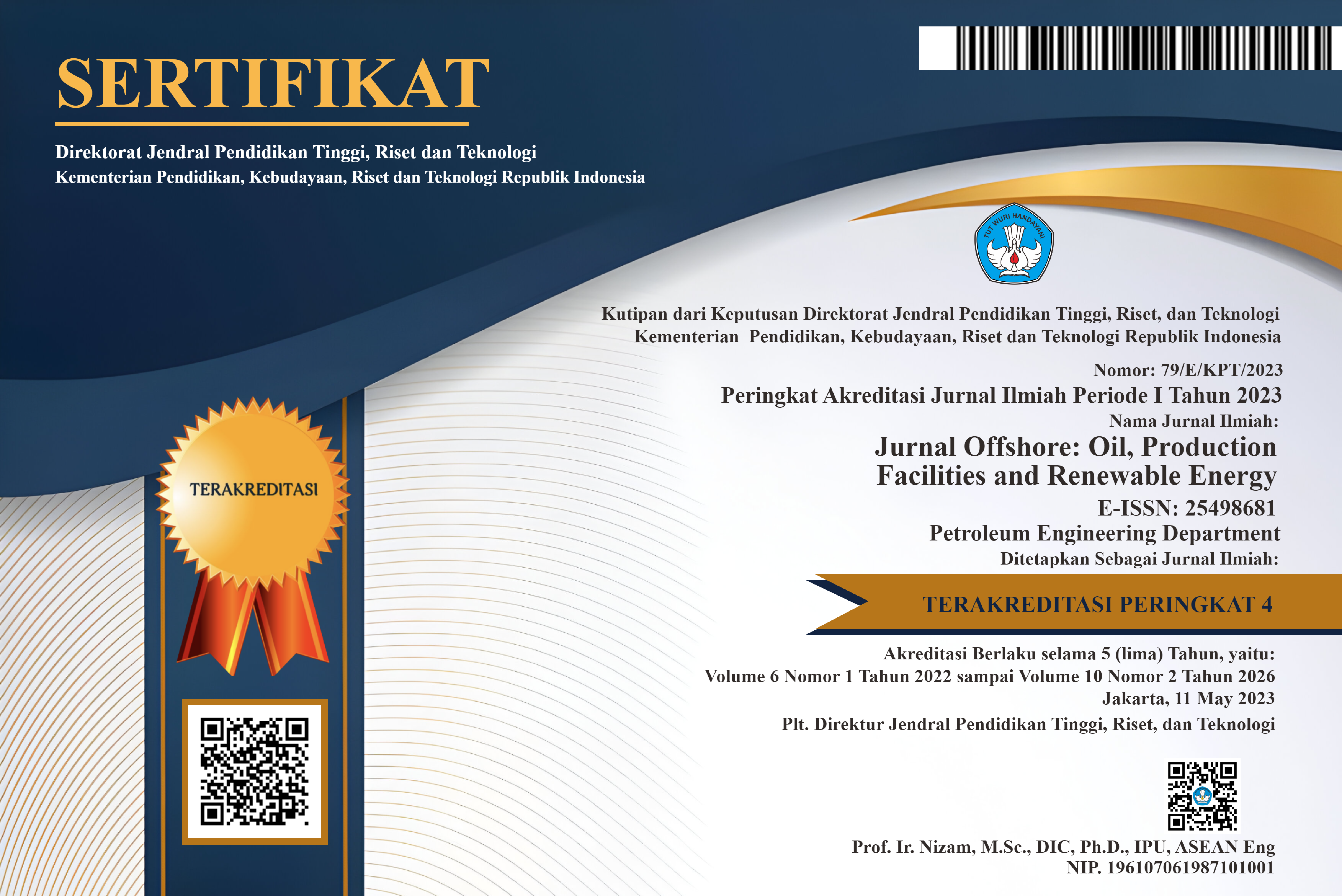ANALISA KOMPOSISI MINERAL CLAY TERHADAP KUALITAS RESERVOIR BATUPASIR LAPANGAN BETUNG, FORMASI AIRBENAKAT, SUB-CEKUNGAN JAMBI, CEKUNGAN SUMATERA SELATAN
DOI:
https://doi.org/10.30588/jo.v7i2.1735Keywords:
clay mineral composition, porosity, permeability, XRD, petrophysicsAbstract
Cumulative fluid production during 2009 - 2021 in the Betung Field, which is the research location and is located in the Jambi sub-basin-South Sumatra Basin (Barber et al., 2005), amounted to 277,923.52 MBbl. The relationship between porosity and permeability can be said in general that if the porosity is greater, the permeability will be greater, but in reality it will be found that certain layers will have large porosity but small permeability, such as in layers containing clay or shale. Mineralogical composition plays an important role, especially with regard to clays, involving several compositions including illite, smectite, kaolinite and chlorite. The presence of quartz and feldspar increases permeability, while clay minerals and calcite tend to have the opposite effect (Jose M. Carcione et al., 2019). The analysis carried out included XRD analysis to determine the mineral composition of the reservoir sandstone of the Airbenakat formation, rock quality analysis (porosity and permeability), well log analysis and then the overall analysis results were linked to production data. Based on XRD analysis, petrophysical analysis of wells 209 and 217 in the Betung field, Airbenakat formation, Jambi sub-basin, South Sumatra basin, the results of XRD and petrophysical analysis show the presence of clay content consisting of Kaolinite, Illite, Smectite and Chlorite which has an influence on reservoir quality, especially permeability, where the greater the clay content, the more obstructed fluid flow is.
References
Asquith, G 1982. Basic Well Log Analysis for Geologists. AAPG, TulsaOklahoma
Barber, A.J., dan Crow, M.J., 2005, Structure and Structural History, Dalam: Barber, A.J., Crow, M.J., dan de Smet, M.J.S., (eds), Sumatra: Geology, Reseouces, and tectonic Evolution, Geological Society, London, Memoirs, 31, hal. 175-233
De Coster, G. L., 1974, Central and South Sumatra Basins .The Geology of The Proceedings Indonesian Petroleum Association, Third Annual Convention, June 1974, 77- 110
Gao, Zhizhang Wang, Yuanqi She, Shiguo Lin, Mingpeng Lin & Chunlin Zhang. (2019). Mineral characteristic of rocks and its impact on the reservoir quality of He 8 tight Sandstone of Tianhuan area, Ordos Basin, China. Journal of Natural Gas Geoscience 4 (205 – 214)
Ginger, D dan Fielding, K. 2005, The Petroleum and Future Potential of The South Sumatra Basin. Indonesiaa Petroleum Assocoation
Hassouta, Buatier, Luc Potdevin & Liewig. (1999). Clay Diagenesis in The Sandstone Reservoir of The Ellon Field (Alwyn, North Sea). Clays and Clay Minerals, Vol. 47, No. 3, 269-285, 1999, DOI: 10.1346/CCMN.1999.0470303
Jose M. Carcione, Davide Gei, Ting Yu, Jing Ba. 2019, Effect of Clay and Mineralogy on Permeability
Irmaya A, Rahmad B, Kristanto D & Buntoro A. (2022). Perhitungan dan Analisa Petrofisik Lapangan Betung, Formasi Airbenakat, Sub-Cekungan Jambi-Cekungan Sumatera Selatan. SEMITAN Jurnal Sumberdaya Bumi Berkelanjutan, J. SEMITAN, 1 (1), 68 – 80
Risha, Douraghi. (2021). Impact of Clay mineral type on sandstone permeability based on field investigations: case study on Labuan Island, Malaysia. J. Phys.: Conf. Ser. 1818 012091
Downloads
Published
How to Cite
Issue
Section
License
Authors retain copyright and grant the Jurnal Offshore right of first publication with the work simultaneously licensed under a Creative Commons Attribution 4.0 International License that allows others to share (copy and redistribute the material in any medium or format) and adapt (remix, transform, and build upon the material) the work for any purpose, even commercially with an acknowledgement of the work's authorship and initial publication in Jurnal Offshore. Authors are able to enter into separate, additional contractual arrangements for the non-exclusive distribution of the journal's published version of the work (e.g., post it to an institutional repository or publish it in a book), with an acknowledgement of its initial publication in Jurnal Offshore. Authors are permitted and encouraged to post their work online (e.g., in institutional repositories or on their website) prior to and during the submission process, as it can lead to productive exchanges, as well as earlier and greater citation of published work (See The Effect of Open Access).















